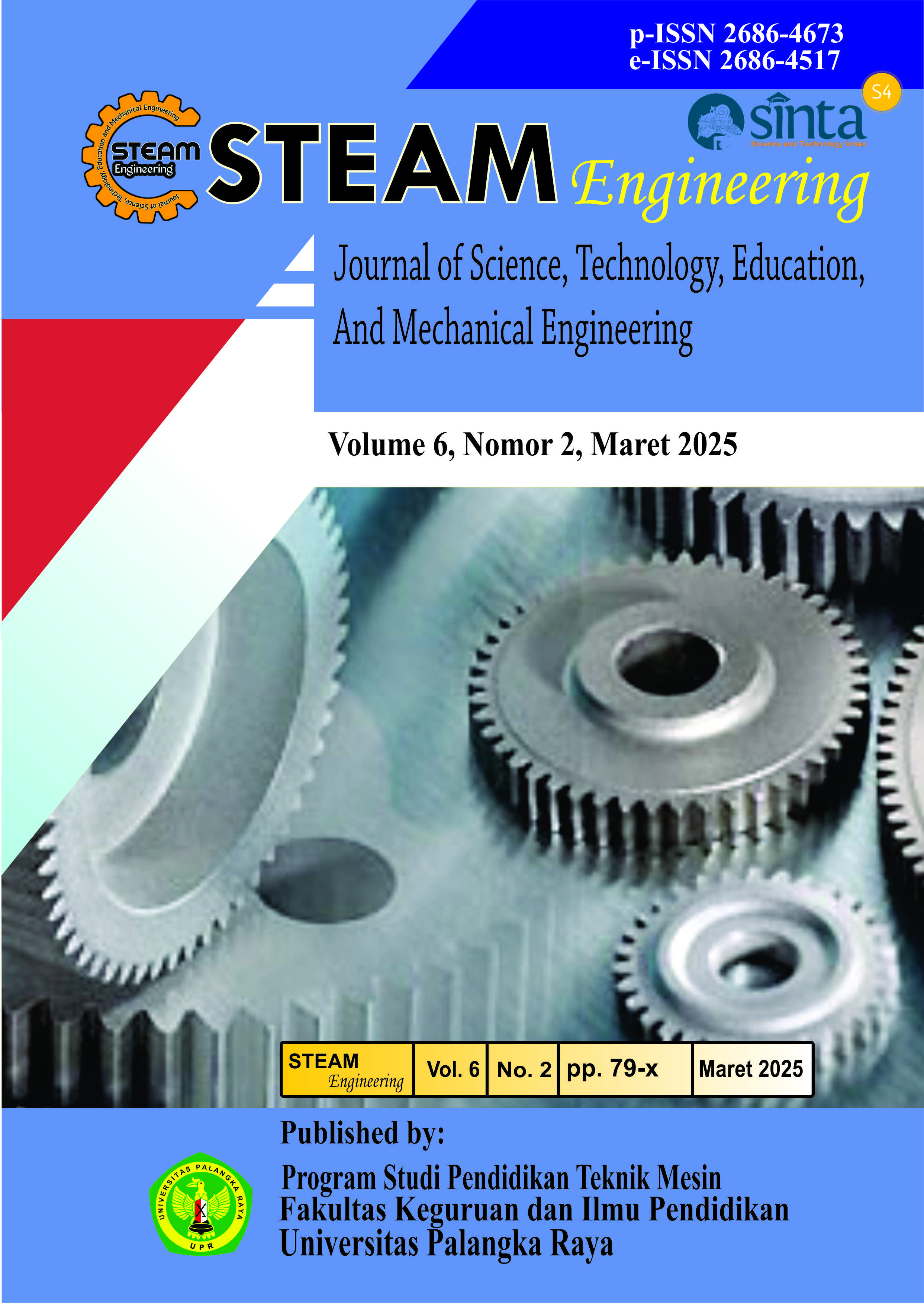ANALISIS KEGAGALAN PADA PATAHAN MATA BOR TIPE HIGH SPEED STEEL
DOI:
https://doi.org/10.37304/jptm.v6i2.19625Keywords:
failure analysis, drill bit, macroscopic observation, microscopic observation, x-ray fluorescenceAbstract
Drill bit failure in the drilling process often occurs due to exposure to mechanical, thermal, and chemical loads during operation. Nachi HSS drill bits, as critical components in the manufacturing industry, are prone to sudden wear and breakage due to dynamic processes involving material fragmentation, friction, and increased local temperatures. This study analyses the root cause of Nachi HSS drill bit failure through fracture investigation, chemical composition, and microstructure. The analysis methods include macroscopic testing to identify fracture patterns, optical microscopy to evaluate surface deformation, and X-ray Fluorescence (XRF) testing to verify material composition. The results showed that the fault was a brittle fracture due to a mismatch in chemical composition: molybdenum (Mo) levels were not detected. At the same time, chromium (Cr) and vanadium (V) only reached 3.85% and 0.95%, 0.45% lower than factory standards. This deficiency reduces resistance to thermomechanical loads, triggering stress concentration and rapid crack propagation during the drilling of ST37 steel material at a speed of 1,800 RPM. These findings emphasize the importance of quality control of material composition and optimization of operating parameters to prevent premature failure.
Downloads
References
Akashi, M., & Kawamoto, T. (1978). The Effect of Molybdenum Addition on SCC Susceptibility of Stainless Steels in Oxygenated High Temperature Water. CORROSION ENGINEERING, 27(4), 165–171. https://doi.org/10.3323/jcorr1974.27.4_165
Andrew, Z. B. (2024). Drill string vibrational analysis and parametric optimization for a portable water well rig development. I-Manager’s Journal on Mechanical Engineering, 14(2), 8. https://doi.org/10.26634/jme.14.2.21011
Bayraktar, Ş., & Turgut, Y. (2020). Determination of delamination in drilling of carbon fiber reinforced carbon matrix composites/Al 6013-T651 stacks. Measurement, 154, 107493. https://doi.org/10.1016/j.measurement.2020.107493
Bazaluk, O., Velychkovych, A., Ropyak, L., Pashechko, M., Pryhorovska, T., & Lozynskyi, V. (2021). Influence of heavy weight drill pipe material and drill bit manufacturing errors on stress state of steel blades. Energies, 14(14). https://doi.org/10.3390/en14144198
Borrisutthekul, R., Makee, C., Kitkamthorn, U., Mitsomwang, P., Chayapiwut, N., Jaisue, A., & Hitoshi, K. (2023). Study The Effects of The Multinite Coat of The High Speed Steel Drill Bit in Drilling. Suranaree Journal of Science and Technology, 30(2). https://doi.org/10.55766/sujst-2023-02-e01577
Farkov, P. M., Il’icheva, L. N., & Finkel’shtein, A. L. (2005). X-ray Fluorescence Determination of Carbon, Nitrogen, and Oxygen in Fish and Plant Samples. Journal of Analytical Chemistry, 60(5), 426–430. https://doi.org/10.1007/s10809-005-0113-y
Ginta, T. L., & Ari-Wahjoedi, B. (2013). Cutting Force and Temperature Variation in Bone Drilling - A Review. Advanced Materials Research, 845, 934–938. https://doi.org/10.4028/www.scientific.net/AMR.845.934
Gruzin, P. L., & Mural’, V. V. (1969). Mechanism of the effect of molybdenum on the reversible temper brittleness of steel. Metal Science and Heat Treatment, 11(3), 240–242. https://doi.org/10.1007/BF00658746
Hicks, J. (1999). Fundamentals of the strength of materials. In Welded Joint Design (pp. 1–16). Elsevier. https://doi.org/10.1533/9781855738980.1
Hicks, J. (2001). Brittle fracture. In Welded Design (pp. 75–81). Elsevier. https://doi.org/10.1533/9781855737624.75
Jeong, M.-J., Lee, S.-W., Jang, W.-K., Kim, H.-J., Seo, Y.-H., & Kim, B.-H. (2021). Prediction of Drill Bit Breakage Using an Infrared Sensor. Sensors, 21(8), 2808. https://doi.org/10.3390/s21082808
Nur Prasetyo, B. (2023). Analisis Kekerasan Pada Mata Bor Berbahan Baja High Speed Steel Hasil Proses Hardening Dengan Pendinginan Oli Dan Coolant. Presisi, 25(1), 1–9.
Ostovan, F., Shafiei, E., Toozandehjani, M., Mohamed, I. F., & Soltani, M. (2021). On the role of molybdenum on the microstructural, mechanical and corrosion properties of the GTAW AISI 316 stainless steel welds. Journal of Materials Research and Technology, 13, 2115–2125. https://doi.org/10.1016/j.jmrt.2021.05.095
Pack, K., & Mohr, D. (2017). Combined necking & fracture model to predict ductile failure with shell finite elements. Engineering Fracture Mechanics, 182, 32–51. https://doi.org/10.1016/j.engfracmech.2017.06.025
Paktinat, H., & Amini, S. (2018). Numerical and experimental studies of longitudinal and longitudinal-torsional vibrations in drilling of AISI 1045. International Journal of Advanced Manufacturing Technology, 94(5–8), 2577–2592. https://doi.org/10.1007/s00170-017-0893-x
Papavinasam, S. (2014). Corrosion Control in the Oil and Gas Industry. Elsevier. https://doi.org/10.1016/C2011-0-04629-X
Pardo, A., Merino, M. C., Coy, A. E., Viejo, F., Arrabal, R., & Matykina, E. (2008). Effect of Mo and Mn additions on the corrosion behaviour of AISI 304 and 316 stainless steels in H2SO4. Corrosion Science, 50(3), 780–794. https://doi.org/10.1016/j.corsci.2007.11.004
Pathak, N., Butcher, C., Adrien, J., Maire, E., & Worswick, M. (2020). Micromechanical modelling of edge failure in 800 MPa advanced high strength steels. Journal of the Mechanics and Physics of Solids, 137, 103855. https://doi.org/10.1016/j.jmps.2019.103855
Puspitasari, P., Soepriyanto, O. R., Sasongko, M. I. N., DIka, J. W., & Andoko. (2018). Mechanical and physical properties of aluminium-silicon (Al-Si) casting alloys reinforced by Zinc Oxide (ZnO). MATEC Web of Conferences, 204(September). https://doi.org/10.1051/matecconf/201820405003
Saai, A., Bjørge, R., Dahl, F., Antonov, M., Kane, A., Diop, J.-B., & Ojala, N. (2020). Adaptation of Laboratory tests for the assessment of wear resistance of drill-bit inserts for rotary-percussive drilling of hard rocks. Wear, 456–457, 203366. https://doi.org/10.1016/j.wear.2020.203366
Shams El Din, A. M., & Wang, L. (1996). Mechanism of corrosion inhibition by sodium molybdate. Desalination, 107(1), 29–43. https://doi.org/10.1016/0011-9164(96)00148-8
Shash, A. Y., El-Mahallawi, I. S., & Amer, A. E. (2017). Options for Nanoreinforced Cast Al–Si Alloys with TiO2 Nanoparticles (pp. 1–12). https://doi.org/10.1007/978-981-10-1602-8_1
Tanaka, M., Wilkinson, A. J., & Roberts, S. G. (2008). Ductile–brittle transition of polycrystalline iron and iron–chromium alloys. Journal of Nuclear Materials, 378(3), 305–311. https://doi.org/10.1016/j.jnucmat.2008.06.039
Ullah, F., Othman, M. B. H., Javed, F., Ahmad, Z., & Akil, H. M. (2015). Classification, processing and application of hydrogels: A review. Materials Science and Engineering: C, 57, 414–433. https://doi.org/10.1016/j.msec.2015.07.053
Vander Voort, G. F. (1978). Macroscopic Examination Procedures for Failure Analysis. In Metallography in Failure Analysis (pp. 33–63). Springer US. https://doi.org/10.1007/978-1-4613-2856-8_2
Yonezawa, T. (2012). Nickel Alloys: Properties and Characteristics. In Comprehensive Nuclear Materials (pp. 233–266). Elsevier. https://doi.org/10.1016/B978-0-08-056033-5.00016-1
Zhang, Q., Zhao, Y., Yuan, G., & Yang, W. (2019). The effect of vanadium on microstructure and mechanical properties of Fe-based high-strength alloys. Results in Physics, 15, 102335. https://doi.org/10.1016/j.rinp.2019.102335












